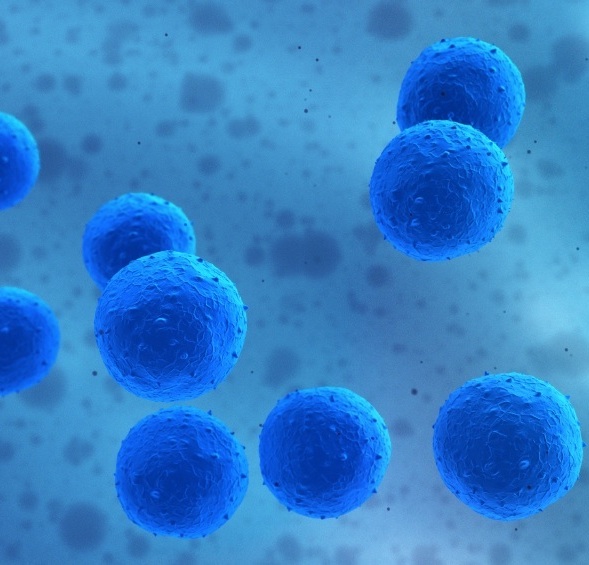Probing epilepsy’s molecular sparks
Mutations in GABA-A receptors – a family of receptors that normally inhibit neuronal activity – are associated with some inherited forms of epilepsy. To explore how mutations contribute to epilepsy development, Mengnan Tian, Ph.D., and Robert Macdonald, M.D., Ph.D., characterized the functional consequences of a particular GABA-A receptor mutation.
The mutation – in the gamma-2 subunit of the GABA-A receptor – was identified in an Australian family with childhood absence epilepsy and febrile seizures. The researchers expressed normal or mutated gamma-2 subunits in cultured cells and transgenic mice. They report in the April 25 Journal of Neuroscience that the mutation altered how the gamma subunit was spliced, resulting in a mutant mRNA that was either degraded or translated into a stable, but shortened, form of the protein.
The study suggests that the mutation reduces surface GABA-A receptor levels, which would reduce the receptor’s ability to “quiet” excited neuronal chatter and make the brain more susceptible to epilepsy. The findings could offer new directions for targeted epilepsy therapies.
This research was supported by a National Institutes of Health grant from the National Institute of Neurological Disorders and Stroke (NS051590) and by a fellowship from the Epilepsy Foundation.
— Leigh MacMillan
Perfect timing for sensory processing
When two sensory inputs – a sight and a sound – occur closely in time, the brain can “bind” them and conclude that they result from a single event (i.e., that they are synchronous). The brain’s ability to do this depends on the amount of time between the two stimuli – a temporal window within which stimuli may be perceived as synchronous.

(Wellcome Images)
Previously, Albert Powers III, M.D., Ph.D., Mark Wallace, Ph.D., and colleagues showed that the window could be significantly narrowed by a computer-based perceptual training program. In the May 2 Journal of Neuroscience, the investigators provide the first look at the brain regions involved in these changes. They found that the posterior superior temporal sulcus (where visual and auditory information comes together) and parts of auditory and visual cortex showed decreased activity on fMRI after training. Additionally, the perceptual training program enhanced the coupling among these regions.
Because abnormalities in multisensory processing may contribute to disorders such as autism, dyslexia and schizophrenia, this information could inform diagnostic strategies and interventions for these disabilities.
The research was supported by the Vanderbilt Kennedy Center for Research on Human Development and grants from National Institute for Child Health and Development (HD050860) and the National Institute for Deafness and Communication Disorders (DC009759) of the National Institutes of Health.
— Melissa Marino
Long live the therapeutic stem cells
Bone marrow-derived mesenchymal stem cells (MSCs) offer promise as a cell therapy for heart repair and wound healing. Low survival and poor engraftment of MSCs limit their therapeutic potential, so researchers are attempting to identify strategies that enhance MSC survival and proliferation, and maintain their “stemness” (inhibit their differentiation into more mature cell types).

(iStockphoto.com)
Pampee Young, M.D., Ph.D., Sarika Saraswati, Ph.D., and colleagues previously showed that inhibition of Wnt signaling – with an over-expressed protein inhibitor – increased the proliferation and engraftment of MSCs in mice. Now, the investigators report that pyrvinium, a small molecule inhibitor of Wnt signaling, increases MSC proliferation and inhibits MSC differentiation in vitro. In an in vivo wound repair model in mice, they demonstrate that pyrvinium enhances long-term MSC engraftment and prevents ectopic differentiation of the tissue into bone or cartilage.
The study, in the March-April issue of Wound Repair and Regeneration, highlights the potential of using a small molecule Wnt inhibitor to enhance stem cell survival and improve cell-based therapies for regenerative medicine.
This research was supported by National Institutes of Health grants from the National Heart, Lung and Blood Institute (HL088424) and the National Institute of General Medical Sciences (GM081635), and by a Veterans Affairs merit award.
— Leigh MacMillan
New clue to ADHD
Attention deficit hyperactivity disorder (ADHD) has been linked to alterations in the production, release and signaling of the neurotransmitter dopamine. Genetic changes that support these alterations, however, have been difficult to associate with specific molecular insults.
Now, Randy Blakely, Ph.D., and colleagues have identified a novel coding variant in a 13-year-old boy with ADHD that prevents the dopamine transporter, a protein involved in inactivating dopamine at synapses, from carrying out its normal function. In essence, the transporter doesn’t go to the correct location on the nerve cell surface, and therefore doesn’t respond to normal regulatory signals, the researchers reported in the April 18 issue of the Journal of Neuroscience. Although the genetic change is rare, it points to a regulatory network where changes may individually or collectively make a much larger contribution to ADHD risk.
This is the second functional dopamine transporter alteration identified by the Blakely group in subjects with ADHD, adding support to the idea that altered dopamine signaling is a key risk factor for the disorder.
The research was supported by National Institutes of Health grants from the National Institute of Mental Health (MH067472, MH090738, MH064913), the National Heart, Lung and Blood Institute (HL56693), and the National Institute on Drug Abuse (DA013975, DA014684), and by the National Science Foundation.
— Bill Snyder
We welcome suggestions for research to highlight in Aliquots. The items should be primary research articles (no reviews, editorials or commentaries) published within the last two months in a peer-reviewed journal. Please send the article citation (PDF if available) and any other feedback about the column to: aliquots@vanderbilt.edu.
Past Aliquots
June 22, 2012
June 8, 2012
May 11, 2012
April 27, 2012
April 13, 2012
March 30, 2012
March 16, 2012













